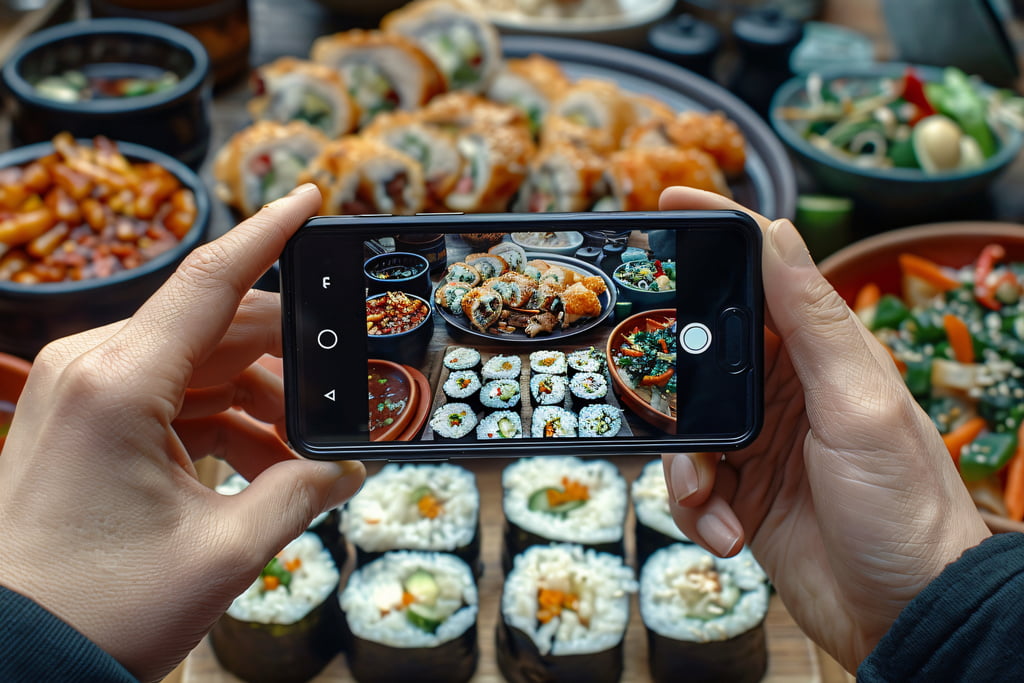In today’s fast-paced digital landscape, social media platforms like TikTok have become game-changers for brands, especially those in the food industry. With its rapidly growing user base and dynamic content format, TikTok offers a unique opportunity for food brands to connect with their target audiences in innovative and engaging ways.
Understanding the TikTok Audience
Before diving into TikTok marketing strategies for food brands, it’s crucial for any food brand looking to make a splash on the platform. With its diverse user base spanning various age groups, interests, and cultural backgrounds, TikTok has quickly become a melting pot of creativity and expression.
Here’s a deeper dive into the demographics and behaviours of TikTok users:
Demographics
Gen Z Dominance:
Gen Z, typically defined as those born between the mid-1990s and early 2010s makes up a significant portion of TikTok’s user base. These digital natives are drawn to TikTok’s bite-sized content and interactive features, making the platform their go-to destination for entertainment and inspiration.
Millennial Influence:
While Gen Z may dominate TikTok, millennials are also active users of the platform. With their purchasing power and penchant for nostalgia, millennials often contribute to viral trends and shape cultural conversations on TikTok.
Older Audiences:
Contrary to popular belief, TikTok isn’t just for the younger crowd. The platform has seen a rise in older users, including parents, professionals, and even grandparents, who are eager to join the fun and connect with loved ones through video content.
Behaviour
Consumption Patterns:
TikTok users are known for their short attention spans and preference for snackable content. They consume vast amounts of content daily, scrolling through their For You Page (FYP) to discover new videos tailored to their interests.
Participation and Engagement:
Unlike traditional social media platforms where passive consumption is more common, TikTok encourages active participation and engagement. Users interact with content by liking, commenting, sharing, and duetting, fostering a sense of community and belonging.
Embrace of Trends:
TikTok thrives on trends, whether it’s dance challenges, cooking hacks, or viral memes. Users eagerly jump on the bandwagon, creating their unique interpretations of popular trends and contributing to the platform’s ever-evolving culture.
Cultural Sensitivity
Diversity and Inclusion:
TikTok prides itself on being a platform for everyone, celebrating diversity and inclusivity in all its forms. Users appreciate content that reflects their lived experiences and resonates with their cultural backgrounds, making authenticity a key driver of engagement.
Global Reach:
With a presence in over 150 countries and 75 languages, TikTok has a truly global reach. Brands must be mindful of cultural differences and sensitivities when creating content for diverse audiences, ensuring that their message resonates universally.
Leveraging TikTok’s Creative Features
One of the keys to success on TikTok is leveraging its creative features to capture users’ attention. For food brands, this means embracing trends, utilizing music and sound effects, and experimenting with visual effects to create thumb-stopping content. Whether it’s showcasing behind-the-scenes footage of recipe creation, sharing cooking hacks, or featuring user-generated content, the possibilities are endless.
Crafting Compelling Content
When it comes to engaging food brand audiences on TikTok, content is king. Brands should focus on creating content that resonates with their target audience while staying true to their brand identity. This could involve sharing mouth-watering recipe videos, hosting cooking challenges, or partnering with influencers to promote products in a creative way.
Crafting compelling content is the cornerstone of success on TikTok, especially for food brands aiming to captivate audiences with mouth-watering visuals and creative storytelling.
Here’s a closer look at some effective strategies and examples for crafting engaging content:
1. Recipe Videos:
Recipe videos are a staple of food content on TikTok, offering a visually appealing way to showcase culinary creations and inspire viewers to try new dishes. Brands can create short, step-by-step tutorials featuring their products or signature recipes, emphasizing simplicity, speed, and deliciousness. For example, a food brand specializing in gourmet sauces might create a quick tutorial demonstrating how to whip up a restaurant-worthy pasta dish using their sauce as the star ingredient.
2. Cooking Challenges:
Cooking challenges are a fun and interactive way to engage with the TikTok community while showcasing a brand’s products or unique cooking techniques. Brands can create challenge prompts, such as #30MinuteMealChallenge or #IngredientSwapChallenge, encouraging users to get creative in the kitchen and share their results. For instance, a spice company could challenge users to create a mouth-watering dish using a specific spice blend and share their culinary masterpieces for a chance to win prizes.
3. Behind-the-Scenes Content:
Offering a behind-the-scenes look at the making of your products or the inner workings of your kitchen can humanize your brand and build trust with your audience. Brands can take viewers on a virtual tour of their facilities, introduce team members, or share insights into their sourcing and production processes. For example, a coffee roastery could film a behind-the-scenes video showing the journey of coffee beans from farm to cup, highlighting their commitment to quality and sustainability.
4. User-Generated Content:
User-generated content (UGC) is a powerful way to foster community engagement and showcase real-life experiences with your products. Brands can encourage followers to share their own content using branded hashtags or by participating in challenges and contests. For instance, a snack brand could ask fans to create and share their favorite snack pairings using the brand’s products, with the best submissions featured on the brand’s TikTok account.
5. Trend-Jacking:
TikTok is known for its viral trends and challenges, which offer brands a golden opportunity to piggyback on popular themes and reach a wider audience. Brands can put their own unique spin on trending challenges, incorporating their products or brand messaging in a creative and authentic way. For example, a dairy-free ice cream brand could participate in the #FakeawayChallenge by showcasing how to make a dairy-free version of a popular dessert trend, such as a Dalgona coffee or whipped matcha latte.
Building a Community
Beyond creating compelling content, successful food brands on TikTok focus on building a sense of community around their products. This involves actively engaging with followers through comments, likes, and shares, as well as responding to user-generated content. By fostering a sense of belonging and inclusivity, brands can turn casual followers into loyal advocates.
Here are some effective strategies and examples for building a community around your food brand on TikTok:
1. Authentic Engagement:
Authenticity is key to building a strong community on TikTok for food brands. They should aim to interact with their audience in a genuine and personable manner, responding to comments, acknowledging user-generated content, and actively participating in conversations. For example, a bakery could reply to user comments with personalized messages, thanking them for their support or answering questions about their products.
2. User-Generated Content:
Encouraging user-generated content (UGC) is a powerful way to involve your audience in the content creation process and strengthen community bonds. Brands can prompt followers to share their own recipes, cooking tips, or meal ideas using branded hashtags, with the best submissions featured on the brand’s TikTok account. For instance, a spice company could launch a #SpiceUpYourLifeChallenge, asking users to share creative ways they use the brand’s spices in their cooking.
3. Community Challenges:
Hosting community challenges and contests is another effective way to engage with your audience and foster a sense of community spirit. Brands can create fun and creative challenges related to their products or brand values, encouraging followers to participate and share their entries on TikTok. For example, a snack brand could launch a #SnackTimeChallenge, challenging users to create their own snack recipes using the brand’s products, with prizes awarded to the most creative submissions.
4. Behind-the-Scenes Content:
Giving your audience a behind-the-scenes look at your brand can humanize your business and build trust with your community. Brands can share glimpses of their production process, introduce team members, or take viewers on a virtual tour of their facilities. For example, a family-owned farm could film a behind-the-scenes video showing the daily operations of their farm, from harvesting fresh produce to packaging and shipping orders.
5. Consistent Communication:
Consistent communication is essential for nurturing a thriving community on TikTok. Brands should regularly post content, engage with followers, and keep their audience informed about upcoming events, promotions, or product launches. For instance, a coffee shop could use TikTok to announce new menu items, share special promotions, or invite followers to participate in exclusive events like virtual coffee tastings or live Q&A sessions with baristas.

Collaborating with Influencers
Influencer marketing plays a significant role in TikTok’s ecosystem, with creators often driving trends and shaping cultural conversations. Food brands can leverage the platform’s influencer network to reach new audiences and amplify their message. Whether it’s partnering with top food influencers or collaborating with micro-influencers, brands can tap into influencers’ creativity and authenticity to connect with consumers.
I’ll be providing a download of an influencer strategy in a future post that you can use, but for now, here’s an in-depth exploration of how to effectively collaborate with influencers on TikTok:
1. Identifying the Right Influencers:
The first step in collaborating with influencers is to identify those whose values, content style, and audience align with your brand. Look for influencers who have a genuine interest in food, cooking, or related topics, and whose audience demographics match your target market. Consider factors such as follower count, engagement rate, and content quality when evaluating potential collaborators.
2. Establishing Authentic Partnerships:
Authenticity is key to successful influencer collaborations on TikTok. Rather than simply paying influencers to promote your products, focus on building genuine partnerships based on shared values and mutual benefit. Collaborate with influencers who genuinely love your brand and are excited to create engaging content that resonates with their audience.
3. Co-Creating Compelling Content:
Work closely with influencers to co-create content that showcases your brand in an authentic and engaging way. Provide influencers with creative freedom to develop content that aligns with their personal style and resonates with their audience. Whether it’s recipe tutorials, taste tests, or cooking challenges, encourage influencers to incorporate your products naturally into their content.
4. Leveraging Influencer Reach:
One of the primary benefits of collaborating with influencers is tapping into their existing audience reach and credibility. Influencers have built trust and rapport with their followers, making their recommendations and endorsements highly influential. Leverage influencers’ reach to increase brand awareness, drive traffic to your TikTok account, and ultimately, boost sales of your products.
5. Tracking and Measuring Results:
Track key performance metrics to measure the success of your influencer collaborations on TikTok. Monitor metrics such as views, likes, shares, comments, and follower growth to gauge the impact of influencer content on brand engagement and awareness. Additionally, track conversions and ROI to evaluate the effectiveness of influencer partnerships in driving sales and revenue.
6. Building Long-Term Relationships:
Invest in building long-term relationships with influencers who are aligned with your brand values and objectives. Cultivate ongoing partnerships with influencers who consistently deliver high-quality content and drive meaningful results. By nurturing these relationships over time, you can create a network of brand advocates who help amplify your message and foster brand loyalty among their followers.
Measuring Success
As with any marketing strategy, measuring the success of your TikTok efforts is crucial for understanding the impact of your content and optimizing your strategy for better results. While TikTok provides a wealth of data and analytics, knowing which metrics to focus on and how to interpret them can make all the difference. Here’s a comprehensive guide to effectively measure success on TikTok for your food brand.
Key Metrics to Track
- Views and Watch Time:
- Views: The number of times your video has been watched. This metric gives you an initial sense of how many users your content is reaching.
- Watch Time: The total amount of time users spend watching your videos. High watch time indicates that viewers are engaged with your content, which is crucial for TikTok’s algorithm favoring your videos.
- Engagement Metrics:
- Likes: A straightforward metric indicating how many users enjoyed your content. High like counts can boost your video’s visibility.
- Comments: Comments provide qualitative insights into how your audience is reacting to your content. Positive comments can be encouraging, while constructive criticism can help you improve.
- Shares: When users share your video, it indicates that they found it valuable enough to recommend to others. Shares can significantly expand your content’s reach.
- Follower Growth:
- Monitoring your follower count helps you understand how your audience base is growing over time. Spikes in followers can often be traced back to specific videos or trends that resonated with viewers.
- Hashtag Performance:
- Track the performance of branded hashtags you use or create. The popularity and engagement around these hashtags can show how well your brand campaigns are catching on.
- Conversion Metrics:
- If your TikTok strategy includes links to your website, product pages, or other calls to action, track the number of clicks and conversions these generate. This helps in understanding the direct impact of your TikTok presence on your sales and other business goals.
- Audience Demographics:
- TikTok analytics provide insights into the age, gender, and location of your audience. Understanding who your audience is can help tailor your content to better meet their preferences and expectations.
Analyzing Performance
- Benchmarking:
- Compare your metrics over different time periods to identify trends and patterns. For example, compare weekly or monthly performance to see if there are any significant changes in engagement or follower growth.
- Content Analysis:
- Identify which types of content perform best by comparing metrics across different video formats and themes. For example, you might find that recipe tutorials outperform behind-the-scenes videos or that videos featuring influencers drive higher engagement.
- Trend Analysis:
- Pay attention to broader TikTok trends and how they influence your metrics. If a particular trend or challenge is driving high engagement, consider how you can incorporate it into your content strategy.
- ROI Calculation:
- Calculate the return on investment (ROI) of your TikTok campaigns by comparing the costs of content creation and promotion against the revenue generated from TikTok-driven traffic and conversions. This helps justify your investment in the platform and guides future budgeting decisions.
Tools for Measuring Success
- TikTok Analytics:
- TikTok’s built-in analytics tool provides a comprehensive overview of your account’s performance, including video views, follower growth, and engagement metrics. Regularly review these insights to stay informed about your content’s impact.
- Third-Party Tools:
- Consider using third-party analytics tools that offer more detailed insights and comparisons. Tools like Hootsuite, Sprout Social, and Socialbakers can provide additional metrics and reporting capabilities.
- Google Analytics:
- For tracking conversions and traffic from TikTok to your website, Google Analytics can be an invaluable tool. Set up UTM parameters for links shared on TikTok to track user behavior and conversions accurately.
Iterating Based on Insights
- Content Optimization:
- Use your analytics insights to optimize future content. If certain types of videos perform better, focus on producing more of that content. Conversely, if certain content types underperform, consider adjusting your approach or experimenting with new formats.
- Audience Engagement:
- Respond to comments and engage with your audience to foster community and encourage more interaction. Use feedback from your audience to guide content creation and improve engagement.
- Campaign Adjustment:
- Adjust your campaign strategies based on performance metrics. If a particular hashtag or challenge isn’t driving the desired results, tweak your approach or try new themes that align better with your audience’s interests.
TikTok presents a unique opportunity for food brands to connect with consumers in a fun, authentic, and engaging way. By leveraging the platform’s creative features, crafting compelling content, and building a sense of community, brands can effectively reach their target audience and drive meaningful results. With the right strategy and approach, TikTok can become a valuable tool for food brands looking to stand out in a crowded market and make a lasting impression on consumers.






